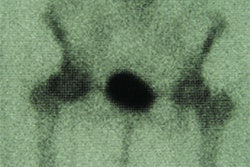The D-dimer assay has enormous potential in critical care, where it can be used to determine who should undergo further imaging. The blood test’s greatest strength lies in its high negative predictive value for deep venous thrombosis (DVT) and pulmonary embolism (PE), according to Dr. Myer Roszler from Baptist Health Systems of South Florida in Miami.
Roszler discussed the results of his small prospective study at the American Society of Emergency Radiology meeting earlier this month in San Francisco. He began by explaining the basic mechanics of the D-dimer assay.
"When patients do have clots, immediately the fibrinogen system goes into effect. This causes a breakdown of fibrinogen into fibrin. A fibrin breakdown product is D-dimer. Any patient who has a clot automatically has D-dimer. Supposedly, patients without clots don’t have D-dimer," he said. "If the D-dimer assay is negative, does the patient really not have DVT or PE?"
The researchers studied 16 patients who were diagnosed with DVT or PE based on helical CT scans, duplex ultrasonography, or lung scintigraphy (V/Q). A control group of 60 patients was also included. The ELISA Liastat D-dimer assay was used and the threshold for a negative result was 0.5-µg/ml. Each test took 20 minutes to perform. This particular D-dimer assay costs $17; the hospital charge is $147, Roszler said.
According to the results, the D-dimer assay was negative for 31 of the 60 control patients (52%). None of the 31 had DVT or PE. Positive results in patients without DVT or PE can come about for a variety of reasons, Roszler explained. "[D-dimer assay] can also be positive in cancer patients, postoperative patients, pregnancy patients, and [patients with] liver disease," he said.
Every study patient had a positive D-dimer assay, giving the test 100% sensitivity based on a strict adherence to the 0.5-µg/ml threshold.
"I had one patient with a reading of 0.55-µg/ml and another with a reading of 0.51-µg/ml. You have to use that cutoff very strictly," Roszler said.
Roszler said he found that the D-dimer assay had good sensitivity and negative predictive value (NPV), but low specificity, especially in patients who may have had a positive result for reasons other than DVT or PE. Improving specificity for the D-dimer assay will require more refined technology.
"Eventually, a new test will need to be invented that will be for a better fibrin breakdown product only associated with DVT or PE," Roszler said.Still, the D-dimer assay can be used to triage patients at risk for DVT and PE, he said. A negative D-dimer, combined with a low or indeterminate V/Q scan, can rule out PE. A patient with a negative D-dimer assay for DVT can probably wait until the next morning for a follow-up ultrasound exam, Roszler said. Finally, a patient with a positive D-dimer should move on immediately to helical CT.
Studies with larger patient populations have reported similar success with the D-dimer assay. Most recently, emergency medicine specialists at the Carolinas Medical Center in Charlotte, NC, tested the diagnostic accuracy of a bedside D-dimer assay in a multicenter study. Working with a total of 380 patients, PE was diagnosed in 64 patients with 20 having abnormal D-dimer assay results. The sensitivity for diagnosing PE was 98%. Among the 316 patients without PE, D-dimer results were normal in 163, for a specificity of 51% (Journal of the American Medical Association, February 14, 2001, Vol. 285:6, pp. 761-768).
In a second study from the Washington University School of Medicine in St. Louis, researchers found that "the introduction of rapid D-dimer assay increased the number of V/Q scans performed because the number of patients screened for PE increased." As a result, DVT or PE was diagnosed in more patients (Archives of Internal Medicine, February 26, 2001, Vol.161:4, pp. 567-571).
Finally, two European studies tested the effectiveness of D-dimer assay when paired with two imaging modalities. At the Daniel den Hoed Cancer Center in Rotterdam, the Netherlands, radiologists assessed the accuracy of a rapid ELISA D-dimer assay for excluding PE compared with pulmonary angiography. They found that the sensitivity for D-dimer for PE was 90% and its NPV was 94% (Thrombosis and Haemostasis, August 2000, Vol. 84:2, pp. 156-159).
Doctors from the departments of clinical radiology and hematology at Rotherham Hospital in the U.K. evaluated the role of D-dimer assay when combined with color Doppler ultrasound in patients with DVT. In this double-blind prospective trial, the researchers studied 143 patients with clinically suspected DVT, which was confirmed or excluded by color Doppler ultrasound within 24 hours of presenting. In 31% of the cases, the ultrasound exam was positive for DVT. Subsequently, the D-dimer assay in these patients showed a sensitivity of 97%, a specificity of 48% and a NPV of 98% (Clinical Radiology, July 2000, Vol.55:7, pp.525-527).
By Shalmali PalAuntMinnie.com staff writer
March 27, 2001
Related Reading
Serial ultrasound not cost-effective for diagnosis of deep vein thrombosis, March 1, 2001
Study claims that ER doctors are too cavalier about ordering V/Q scans, November 28, 2000
Click here to post your comments about this story. Please include the headline of the article in your message.
Copyright © 2001 AuntMinnie.com



















